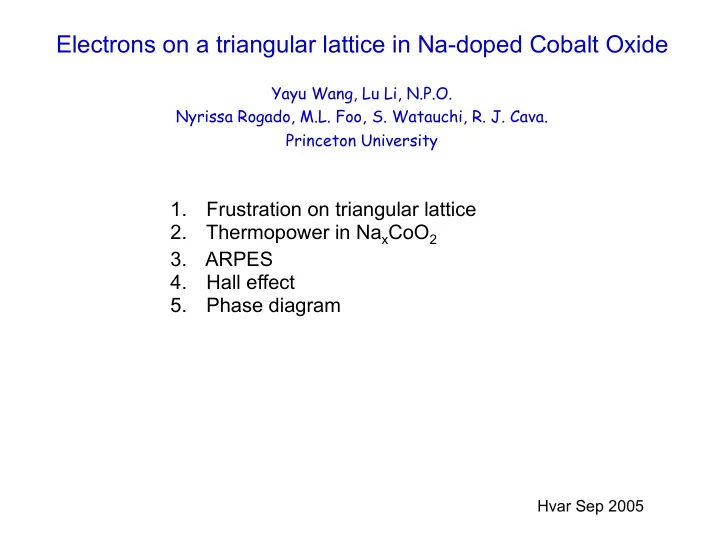

Electrons on a triangular lattice in Na-doped Cobalt Oxide Yayu Wang, Lu Li, N.P.O. Nyrissa Rogado, M.L. Foo, S. Watauchi, R. J. Cava. Princeton University 1. Frustration on triangular lattice 2. Thermopower in Na x CoO 2 3. ARPES 4. Hall effect 5. Phase diagram Hvar Sep 2005
� Thermopower W specimen holes I p J n J Q Thermoelectric cooler Heat current density J Q accompanies charge current density J Ratio of currents J Q /J = Π (Peltier coeff) Usually measured as thermopower S S = Π / T = J Q / JT Heat current density J Q = S T J
Figure of merit for thermoelectrics Max temp. difference S = thermopower Δ T max = ½ ZT 2 ρ = resistivity κ = thermal conductivity The ZT number ZT = (S 2 / ρ )(T/ κ ) ZT ~ 1 in Bi 2 Te 3 (at 300 K) Maximize ZT and minimize resistivity (physically conflicting demands)
Na x CoO 2 Terasaki, Uchinokura 1997 building block tilt Octahedra tilted to form a layer Co Na ions (dopants) sandwiched btw Na layers of tilted CoO 2 octahedra Co ions define a triangular lattice
Large thermopower S of Na x CoO 2 Terasaki et al Phys. Rev. B (1997) x = 0.71 S Sommerfeld
Co Na as grown
Metallic resistivity but antiferromagnetic in spin response (Curie-Weiss Metal)
Field dependence of S in Na x CoO 2 Wang et al. Nature ‘03 - T V B S • In-plane field H || - T • Strong field suppression of Thermopower
Spin contribution to thermopower (Chaikin Beni, 1976) J Q J J = nev Spin entropy per carrier = k B log 2 J Q = nv k B T log 2 S = J Q /JT = (k B /e) log 2 ~ 60 µ V/K Not signif. in conv. metals
S(H)/S(0) - 1 Conclusion : 1. Spin entropy is the source for enhanced thermopower 2. Key for new thermo-electric materials -- Spin Wang et al. Nature ‘03
ARPES: Weak quasiparticle dispersion Z. Hasan et al. (PRL ‘04) Small bandwidth à Low degeneracy T Single-particle hopping : t < 0 and |t| ~ 10 meV (bandwidth < 100 meV) Momentum Kinetic energy (eV)
Fermi Surface of Na 0.71 CoO 2 measured by ARPES Hasan et al. Large hole-like FS Hopping integral t ~ 10 meV Fermi velocity < 0.4 eV.A Absence of small pockets
Behavior of quasi-particles versus temperature ARPES Quasiparticles are coherent Resistivity is T-linear only below 150K below 100K
Insulating state Na x CoO 2 Foo et al. Multiple electronic phases vs. Na content PRL ‘04 as grown
Calibration of the Na content vs. c-axis lattice parameter Calibration procedure • treat powder and crystals under same conditions • powder x-ray diffraction to get c-axis lattice constant • ICP-AES to determine the Na contents of powders • x vs. c-axis calibration curve • from the c-axis of crystal, extract the Na content
x = 0.50 (1/2): • � Two kinks at T c1 =88K and T c2 =53K in χ • � Resistivity shows insulating behavior below T=53K
An unexpected insulator at x = ½
b a b* a* Na Na vacancy Electron diffraction at 300K shows the superlattice formed by the Na ions, consistent with a zig-zag order Zendbergen et al., condmat/0403206 (2004)
Foo et al., PRL ‘04 Thermal Conductivity Hall coefficient
Foo et al., PRL ‘04 Systematic change vs x except at x = ½ Susceptibility Resistivity
Na x CoO 2 Foo et al. Multiple electronic phases vs. Na content PRL ‘04 as grown Spin ordere d
Is the 1-band description adequate? Do e g and t 2g bands cross as x 1 ? Is this limit a band insulator? At x = 1, all Co are 3+ Is system a band insulator?
ρ (m Ω cm)
Resistivity of Na x CoO 2 in limit x 1 300 m Ω cm Resistivity profile same as x incr. to 1 aside from scale factor X = 0.82 150 X = 1 m Ω cm 0 holes staging phase separation for x > 0.75 For x 1, remaining holes segregate into layers! But bulk is insulating.
Further enhancement of thermopower x = 0.71 x = 0.88 S Sommerfeld
Na x CoO 2 (x = 0.88) ZT
In doping interval 0.75< x < 1.0 1. Staging phase segegation of holes endemic 2. A band insulator in the limit x = 1.0 3. Thermopower is very large in this range (5 times value in x = 0.71 at 100 K) 4. Resistivity remains low 5. ZT value exceeds that of Bi 2 Te 3 at 100 K. 6. Exploit staging/segregation to optimize ZT?
T-linear Hall coefficient Yayu Wang, 03 R H conv. metal
Why is R H T -linear? Hopping Hall current in triangular lattice (Holstein, ‘61) 2 σ H ~ t 12 t 23 t 31 ~ i t 3 exp(i α ) t 12 φ Peierls phase α = 2 π φ / φ 0 1 3 t 13 High-frequency R H * in tJ model (B.S. Shastry ‘93, ‘03) σ H ~ i( β t) 3 exp(i α ) β t << 1 ( β = 1/T) σ ~ ( β t) 2 T -linear? R* H ~ σ H /H σ 2 ~ ( β t) -1 Hopping on Kagome lattice (Maekawa)
Unusual electronic behavior in Na x CoO 2 Strongly correlated s = ½ holes hopping on triangular lattice • � Paramagnetic Metal (x ~ 1/3) High conductivity, superconducting with H 2 O intercalatn. • � Charge-ordered Insulator (x = ½ ) Na ion ordering, hole ordering (stripes?), giant thermal conductivity • � Curie-Weiss metal (x ~ 2/3) Curie-Weiss susceptibility, metallic cond., large thermopower from spin entropy, T-linear Hall coef. • � Spin Ordered Phase (x > ¾ ) Even larger S than at 0.7, ZT value at 100 K is encouraging
En d
Recommend
More recommend